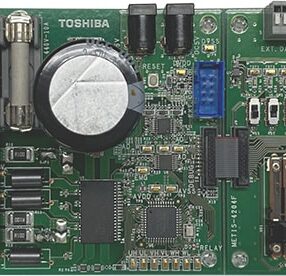
Motors power everything from household appliances to industrial machinery in today’s world. The importance of optimizing motor control for energy efficiency cannot be overstated, given that motors account for a significant portion of global energy consumption. This article delves into the structure of motors, the use of variable frequency drives (VFDs), and the solutions for motor control applications, including hardware support and advanced algorithms.
The widespread use of motors Appliances like washers, dryers, dishwashers, and pool pumps all have motors, which are essential to our day-to-day lives. They are also important in automotive applications, where the number of motors in a modern automobile can range from 40 to 100, depending on the model and trim level. Motors play a big role in many industrial settings, especially in robotics and factory automation. Figure 1 shows the range of motor applications from household appliances to automotive and industrial.
Motors account for approximately half of all global energy consumption, according to the Energy Information Administration. In industrial applications, this figure can exceed 80%. For instance, in the United States, the total energy consumption in 2022 was 4.07 trillion kilowatt-hours, equating to a daily consumption of 11.2 billion kilowatt-hours. Improving motor efficiency by just 1% could save 56 million kilowatt-hours of energy daily.
Key trends in motor efficiency
Figure 2 shows the four avenues to improve motor efficiency: energy efficiency motors, the use of drives and better electronics, advanced algorithms, and the integration of IoT. This section will touch upon these four topics and go into more detail.
Energy-saving motors One of the primary trends in motor efficiency is the transition from traditional motors, such as AC induction motors, to more efficient types like brushless DC (BLDC) motors, permanent magnet synchronous motors (PMSM) and interior permanent magnet (IPM) motors. These motors offer higher efficiency and improved performance. Additionally, advancements in materials, such as the use of amorphous metals and rare earth magnets, have further enhanced motor efficiency.
Technological advancements In the realm of motor technology, advancements in materials and design have significantly enhanced the efficiency and performance of motors over the past century. As shown in Figure 3, a motor typically consists of end bells, a rotor, bearings, and a stator with windings.
Over the years, the materials used in these components have evolved. For instance, the transition from aluminum to copper in the rotor and stator coils has improved conductivity and efficiency. In addition, advancements in manufacturing tolerances have resulted in lower levels of noise and increased levels of productivity. One notable trend in motor technology is the use of amorphous materials in rotors and stators. Historically, silicon steels were utilized, but their hysteresis and eddy current losses were high. Amorphous materials like metallic glasses, which have lower losses and thus higher efficiency, are now being used in their place. Stronger magnets, like those made of rare earth elements like neodymium, iron, and boron, provide more torque and efficiency for permanent magnet motors. However, due to sustainability concerns, alternatives like aluminum, nickel, chromium, and ferrite-based magnets are being explored for their good properties over a range of temperatures and strong magnetic fields.
Aufbau of the motor The transition from journal bearings to ball bearings has played a significant role in reducing friction and improving tolerances, thereby enhancing motor efficiency. Over the past century, motors have become considerably smaller while maintaining the same power output. A modern squirrel-cage rotor, three-phase, 5-horsepower induction electric motor (SCIM) weighs approximately 20% less than a motor with the same power rating in 1910, as depicted in Figure 4. This reduction in size can be attributed to the use of lighter and more efficient materials, as well as advancements in thermal and electrical insulation.
Lighter motors are particularly beneficial for automotive applications, where reducing weight can lead to increased efficiency and the ability to integrate motors into more compact spaces. As we continue to explore new materials and designs, the potential for even greater efficiency and performance in motor systems remains promising.
Variable frequency drives
Variable frequency drives (VFDs) have become increasingly popular for controlling motor speed and improving efficiency. Reduced energy consumption is achieved by VFDs by matching the load requirements to the motor’s speed. In VFDs, the switch to silicon carbide (SiC) and gallium nitride (GaN) technology from insulated gate bipolar transistors (IGBTs) has also resulted in faster switching and improved efficiency. VFD impact
Variable Frequency Drives (VFDs) have revolutionized motor control by allowing precise control over motor speed and torque. This technology makes the motor work better and makes the system work better. A VFD adjusts the frequency and voltage supplied to the motor, enabling it to operate at the most efficient point for a given load.
For instance, throttling valves control flow rates in traditional motor systems, which results in significant energy losses because they frequently operate at full power. VFDs, on the other hand, adjust the motor speed to match the required flow rate, eliminating the need for throttling and increasing overall system efficiency. As shown in Figure 5, studies have shown that switching to a VFD can more than double the efficiency of a motor system, from around 31% to 72%.
Motor control hardware
To get the most out of VFDs, you need a variety of power management tools, as shown in Figure 6. Precision switching is made possible by SiC AC-DC converters with gate drivers, which make power conversion more effective. To convert DC to variable AC, MCUs with motor-specific peripherals and specialized algorithms, such as dsPIC33 digital signal controllers (DSCs), can be optimized. Finally, integrated sensors offer real-time feedback on current, voltage and temperature, enhancing system reliability.
Advanced control algorithms
V/F control for AC induction motors is a straightforward and cost-effective method, but it may not be the most efficient. More advanced algorithms, such as six-step commutation for BLDC and PMSM motors, can offer sensor or sensor-less precision torque control. For high-performance speed, position, and torque control, field-oriented control (FOC) employs, for instance, a single-cycle MAC with data saturation, zero overhead looping, and barrel shifting. Figure 7 shows a sample block diagram for FOC of a motor using the least FPGA resources to execute a full motor control algorithm.
The Zero-Speed/Maximum-Torque (ZS/MT) control algorithm is a new variation of the sensorless FOC algorithm that enables the adoption of sensorless control techniques in high-torque or low-speed motor control applications. ZS/MT is ideal for applications like drilling machines, garage door openers, automotive starters, and e-bikes because it uses a dependable initial position detection (IPD) method based on high-frequency injection (HFI) to determine the precise rotor position at zero and low speeds, eliminating the need for Hall effect sensors. AI/ML integration with IoT The integration of IoT and AI technologies has revolutionized motor control. Sensors are used to detect current, torque, and rotor position, among other parameters, information that is then fed to MCUs for processing. These systems can use ML to integrate predictive maintenance by analyzing sensor data to anticipate motor failures or maintenance requirements. Predictive maintenance ensures that motors operate at peak efficiency and performance, reducing the likelihood of unexpected breakdowns. By continuously analyzing parameters such as current, torque and vibration, predictive maintenance ensures efficient motor operation and minimizes downtime. By monitoring the motor’s quiescent current, systems can, for instance, use a classification model to determine the motor’s operational state, determining whether it is functioning normally or experiencing anomalies like an unbalanced load or a broken bearing. Improved motor control Optimizing motor control for energy efficiency is crucial for reducing global energy consumption and improving the performance of various applications. Significant energy savings are possible by switching to efficient motors, utilizing variable frequency drives (VFDs), implementing advanced control algorithms, and integrating IoT and AI technologies. As the demand for energy-efficient solutions continues to grow, advancements in motor control technology will play a vital role in meeting these needs.
Pramit Nandy is a product marketing manager at Microchip Technology Inc., focused on motor control applications. Nandy has been employed by Microchip since 2021, and prior to that, he held the position of product marking manager at Onsemi. He holds a master’s degree in electrical engineering from Arizona State University.



























